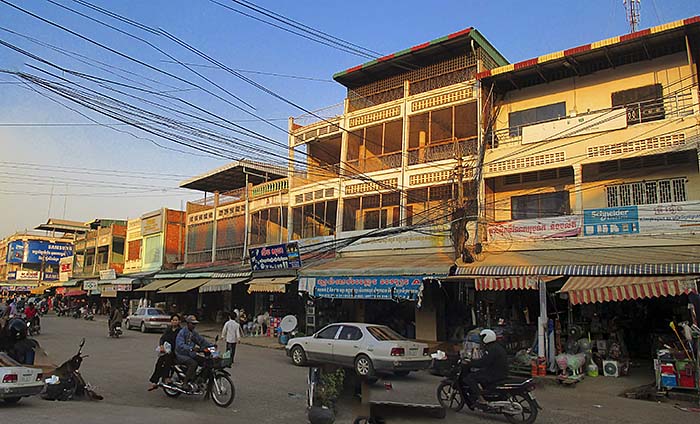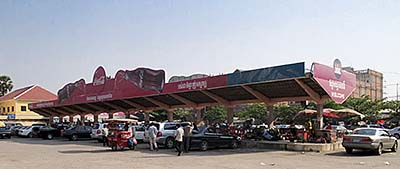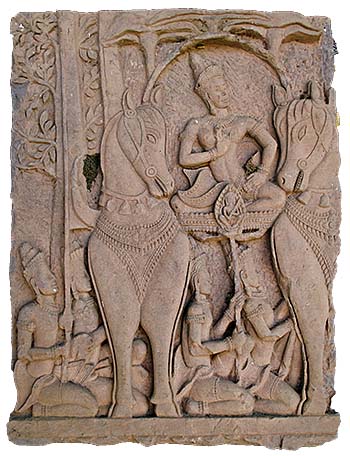Sisophon Town
When arriving here on the bus, your first impression might be it's all a big mistake and you have been dropped mistakenly on a waste-disposal site. Sadly, soon it turns out to be Sisophon and you arrived at the bus station. Another boomtown with it's dirty growth.

Boomtown Sisophon, a permanently expanding building site. Image by Asienreisender, 1/2016
This blasted and no more too small place is now the capital of Banteay Meanchey Province. Officially called and written Serei Sophon (Serey Saophoan, translatable to 'beautiful freedom', meaned freedom from Siamese rule, ignoring the very fact of French colonial rule after the renaming), how it also appears on kilometer stones and road signs, none of the locals call it so. Since it is a former Thai town, it's Thai name was Sri Sophon. In the forced 1907 land exchange deal, the area came together with Battambang, Pailin and Siem Reap to French Indochina, and was insofar incorporated in modern Cambodia since then.
Sisophon is a hub also for the traffic particularly from notorious Poipet, what is known as the most annoying border point to enter [S]Cambodia and continue either to Siem Reap (Angkor Archaeological Park) or southwards to Phnom Penh. To the north one can follow NH69 along the biggest sight in the province, the Angkorean temple site of Banteay Chhmar, to Samraong. From there it's possible to continue to O'Smach and/or Anlong Veng, both border crossings to Isan, Thailand's northeast.
Sisophon Downtown

It's interesting to see that all the Cambodian towns look similar in the style of the buildings. It's all built in the same, ever repeating pattern. The same is so for Thailand, it's just that the pattern is a different one there. All these new buildings are of a thorougly cheap and unsolid quality. Nothing is properly made, particularly not the installations as electronics and drainages. It's all brandnew rubbish and won't last long. That guarantees also that these buildings will remain as eternal building sites. Image by Asienreisender, 1/2016
Sisophon has an old, rotten train station along the ceased railway line between Poipet and Phnom Penh. Planning has it that the railway connection will be reawakened and connecting Thailand with the Cambodian capital and lead further east to Vietnam.
The southern part of town is touched by Stueng Sisophon, which goes it's way towards Tonle Sap Lake. Its catching a great deal of pollution here.
The Bus Station

The strange thing here is that there is no bus at the station; it's all about car taxis, a kind of 'wild' taxis without taxometers. They go to neighbouring cities and collect passengers as an alternative to the big buses. Sometimes also private drivers come here and take passengers with them to gather petrol money. Having a car does not necessarily mean one can also affort the petrol to drive it. There must be another bus station rather around town for the buses. Image by Asienreisender, 1/2016
It's possible to explore the town on foot, although it's the usual fight against the dirty, often blocked sidewalks and the chaotic traffic. There is not much to see in the place apart from the beehive activities of the locals and a few neglected old buildings from the French colonial time, the only ones who have at least some charme.
A landmark here is Phnom Bak, a mountain which dominates the city landscape. There is a concrete tower on the peak from where one has a grand view over town, particularly before the sun sets west behind it. There are also some telecommunication towers on the mountain.
Ugly Sisophon is not at all touristic, althought there are a lot of hotels and guesthouses in town. They are mostly for businesmen who visit the place; if you see a Westerner here, he/she is probably working for a NGO.
Sisophon Provincial Museum

This small building lies in a neglected, dusty park in town. The small yard was blocked with a car, parked directly in front of the entrance. The museum was closed, but a few guys were strolling around there, some having food. At my appearance they watched me and became lively. The smell of money was in the air - a visitor! They opened the door then. Seems, they have a visitor a year, because it all looked like untouched for a long time. Dust on the brochures, the floor, the cabins.

An Angkorean knight. A replica or an imagined work in the museum's yard. Image by Asienreisender, 1/2016
The building has been built in 2004. The money for the construction came, as always in Cambodia, from abroad. There was a recent exhibition labelled 'Ancestors of the Khmer Empire', but it is more than doubtful that the pre-historical people whose artefacts were displayed here were the ancestors of the medieval Khmer. However, in terms of marketing it sounds good to connect it to the famous empire of Angkor. Who cares for reality?
When the archaeological site of Phum Sophy was discovered in 2007, artefacts in great number from bronze and iron ages were found. Soon the message of the site went round in the circles of art dealers, attracting locals to start looting the site and selling artefacts to dealers. The looting did a great damage, and there is no reason to believe that the Cambodian authorities were anyhow able to prevent the looting. Police was sent for guarding the place, but, well, police... Wouldn't wonder if they became the managers of the artefact trade. Would rather wonder if not.
Radiocarbon dating suggests the age of the site between 125 CE to 562 CE.
The cultural heritage in such chaotic countries is under threat not only by looting, but also by the rampant, unplanned and unorganized urban growth. The devastation of whole cultural landscapes, ancient monuments, historical towns and other features means a loss for the knowledge of mankind about itself that can not be reversed. Images and photocomposition by Asienreisender, 1/2016